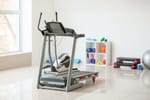One of the most important aspects of working out that a lot of people usually don't consider is recovery.
What they don’t realize is that our muscles aren't actually built during the workout.
Instead, they're built during periods of rest, relaxation, and while we’re asleep.
If you aren't waiting long enough between exercising a muscle to allow for proper recovery, you run the risk of overtraining.
This could lead to injuries and drastically increase the amount of time a muscle needs to recover.
Also, because the muscle hasn't had time to fully build muscle tissue from the last workout, you won't get the maximum gains possible from your exercise movements.
When you train a muscle it’s broken down at a cellular level.
During the recovery period, the muscle cells build themselves back up bigger and stronger (hypertrophy).
On the other hand, waiting too long between workouts can cause your muscles to shrink (atrophy) and become weaker.
I don’t know anyone in their right mind who’d want to train harder only to get negative results from all that effort.
The reason most workout enthusiasts continue to make this mistake is that they haven’t been made aware of the recovery process.
Do you know someone who works out all the time, and eats fairly healthy, but their physical appearance doesn’t match all the effort put into their regimen?
Oftentimes, these folks don’t even look like they work out at all.
The reason is that they are most likely overtraining due to not recovering properly.
This overtrained state caused them to not make any significant progress.
Therefore, they physically look as if they don’t work out at all.
Today, I’m going to share four tips that can help you properly recover, avoid overtraining, and build lean muscle mass.
Let’s do this…
1)) Rest Muscles for Approximately 36 Hours
Sports scientific research has shown that muscles typically take about 36 hours to fully regain their previous strength.
Each bodybuilder’s strength and stamina are recorded before the experiments are conducted, as well as how long it took them to achieve the same level of strength after a workout.
The results of these experiments consistently match those reported by experienced bodybuilders.
It typically takes about a day and a half of rest to give your muscles the downtime needed to recover properly.
If you're just getting started with strength training, don't expect your recovery time to be the same as an experienced athlete.
It's entirely normal for a beginner to take 3-6 days to recover from a strenuous workout.
You must give your body time to adjust to recovery.
Simply space your workouts out so it's just a few times a week and then gradually shrink the time between exercise sessions.
For example; let’s say that you train your thighs on Monday and assume you’re a beginner. For the first 60 to 90 days or so, you would train them only on Mondays or one day per week. Then as your body’s recovery capabilities increase, you could begin training them twice per week, for example; Monday and Friday.
After you move from a beginner to an intermediate level in your physical fitness is when you should apply the 36-hour recovery principle.
Otherwise, your workouts if performed too frequently will do more harm than good and cause you to overtrain, which can actually result in the loss of muscle mass.
2)) Listen to Your Body
No matter how much scientific research data we have at our disposal regarding physical recovery between workouts, keep in mind that the right amount of time to recover after strength training sessions varies from person to person.
There is no one-size that fits all rules, only guidelines.
It also varies from muscle group to muscle group, and exercise to exercise.
The most important thing you can do is listen to your body.
Getting slightly sore one to two days after a workout is normal, especially when you increase the resistance, number of repetitions, and intensity levels, or try a different exercise your body isn’t accustomed to.
This is called onset soreness and usually goes away within a few days if you recover properly.
You shouldn't feel like you're in excruciating pain.
If the pain feels sharp rather than dull or if you feel immobilized by the pain, chances are you're pushing too hard.
If you continue down this road without implementing a recovery strategy, this could lead to chronic soreness, which leads to overtraining, which makes you more susceptible to getting injuries.
Not to mention, increases the time it takes your muscles to recover.
Yes, this is a negative domino effect.
With that said, don't let mild soreness completely stop you from working out - getting more circulation in your body by using lighter resistance can be a good way to get rid of soreness.
Just don't push your body past the point where you don’t feel healthy.
No one or tool can gauge how you feel better than you can.
So, I highly recommend getting in-tuned with your body by listening to the signals it sends you.
3)) Split Your Body Parts Up
One of the most common ways to address the issue of recovery time is by grouping and training certain muscle groups on different days.
Here’s an example to illustrate:
Monday: Upper Quads, Calves, & Cardio
Tuesday: Chest & Abs
Wednesday: Back (upper & lower), & Cardio
Thursday: Biceps, Triceps, & Forearms
Friday: Shoulders, Hamstrings, Abs, & Cardio
Saturday: Recovery
Sunday: Recovery
This type of split allows you to give each muscle group the rest they need, while still proving the stimulation needed to continue making strength and size gains.
Once your body is able to handle the stress from this type of split in terms of its ability to properly recover, you can begin training each muscle group twice per week.
That’s your choice to make.
Building your body is like building a home; you must establish the foundation first before progressing to the next phase.
4)) Using Nutrition and Supplements to Aid in Recovery
According to the International Sports Sciences Association, recovery is defined as the return to a normal state of health, mind, and strength.
A recovery strategy consists of more than waiting 36 hours between training each muscle group and getting enough rest.
There are other components that should be applied such as healthy foods, supplementation, message therapies, etc.
Healthy foods and supplements are used to replenish your body with vitamins, minerals; complex carbohydrates in the form of glycogen, good fats, and proteins that it needs to recover and prepare for future activity.
Remember, your muscles are built after the workout when you’re recovering by getting enough sleep and eating healthy.
Nutrition Tips To Boost Recovery:
- Consume a high-quality protein Whey Protein drink after each workout
- Eat a small meal every 2 to 3 hours (including protein, complex carbs, and good fats)
- Drink the proper amount of water per day
- Take a Branched-chain amino acid (BCAA) supplement to help with recovery
- Take high-quality multivitamins that provide you with micro-nutrients
Consistently implementing those nutrition tips alone can drastically boost your recovery capabilities.
Remember, our bodies consist of many different parts that work together very efficiently and naturally take advantage of the principle of synergy.
According to Oxford Languages, Synergy is the interaction or cooperation of two or more organizations, substances, or other agents to produce a combined effect greater than the sum of their separate effects.
A recovery strategy takes full advantage of the power of synergy, especially when you combine rest, relaxation, sleep, healthy foods, and supplementation.
Bonus Tip: Using a Portable Massager to Aid in Recovery
Handheld percussive therapy devices have become all the rage these days and more and more wellness companies are creating their own versions.
And for good reasons, these portable devices can perform deep tissue muscle massages, help alleviate pain, reduce soreness, increase range of motion, reduce adhesion knots, and boost recovery.
If you’ve never had the pleasure of using a portable massager, you don’t know what you’re missing.
It will make your muscles feel amazing as if you just got a massage from a professional masseuse.
No exaggeration!
I highly recommend adding a portable massager to your recovery strategy, because it’ll be well worth it.
Keep in mind the principle of synergy and the more recovery tools that you incorporate into your recovery strategy, the faster you’ll make physical progress without overtraining.
Let’s wrap this up…
Conclusion
I just provided you with Four Post Workout Recovery Tips That Can Increase Muscle Tone!
Before reading this article, you may or may not have thought about the importance of proper recovery between training each muscle group.
The two biggest reasons people don’t get the physical results they desire despite how hard they workout is due to improper recovery and a poor diet.
Since all the components of our bodies work together, being deficient in one or more areas creates imbalances, which is the opposite of the principle of synergy and results in a negative domino effect.
For instance; if you don’t allow enough time between training each muscle group, that can lead to overtraining, which could open you up to injuries, weaken your immune system, cause you to lose lean muscle mass, lead to chronic soreness and fatigue, and take even longer to recover.
You see, recovery is an extremely important part of working out and when ignored whether intentionally or not, can wreak havoc on your body.
There’s a lot more to recovery than what I explained today.
However, you now know how critical it is to implement your own recovery strategy.
I’ve provided you with a good foundation upon which you could build upon.
From this day forward, I highly advise you to make recovery your number one priority, because muscle tone is built after the workout.
Download Our Free E-book!







